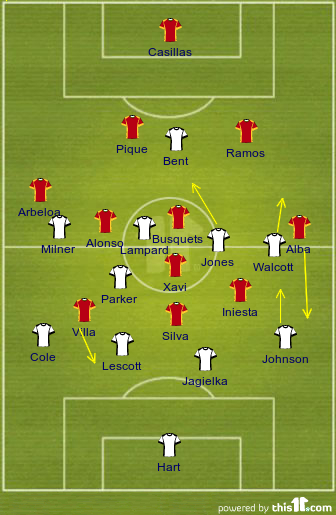England vs. Spain: a Tactical Review of the World Football Game at Wembley
November 12, 2011
England played Spain at Wembley today, winning 1-0. Contrary to people's expectations, England were not completely dominant in terms of shots on target. A resolute defensive performance saw them holding off the dogged,metronomic Spanish Tiki- Taka.

England played a 4-3-3 system, which was similar, at times, to 4-1-4-1.The defence was largely tactically uninteresting. It stayed static as Spain's interchanging forwards looked to play killer ball in behind.
Lescott attacked the ball more, while Jagielka stayed static. Lescott and Jagielka kept calm in the face of Spanish passing and dealt with it relatively well, letting in only few chances.
When England attacked, they did so largely through the right, where Johnson and Walcott took advantage of Jordi Alba's forward runs. Most of England's chances came through the right.
The standard defensive midfielder, Scott Parker started in his holding role. When managers sometimes say "sit in front of the back four," they don't mean it completely. But that is what Parker did—a conventional holding role, much like he plays for Tottenham.
He stayed static, felt comfortable in possession and largely did not lose the ball.
Next, in the midfield came Phil Jones, who played a box-to-box role in the center of midfield. Whenever England won the ball in the center of midfield or in defence (not often), they countered with a set of speedy, direct passes, not long-ball.
Because of Alonso and Busquets's focus on Lampard, Jones was left free into space in front of the final third, often because he won balls from midfield and his energy and space brought him through.
However, his pass was lacking.
Lampard was largely shackled by the excellent Spanish midfield. It wasn't specific man marking, but general pressing from every player. Bent looked isolated upfront. Milner was less free than Walcott due to Arbeloa's defensive positioning, and England's tendency to attack through the right
Ramos and Pique played. Ramos moved slightly to the right tending to his natural position, and was there when Walcott broke through. Xavi played his usual attacking midfield position. Silva started to play as a false 9, with Iniesta tucking in alongside, and Villa coming through the left.
Substitutions changed the game. A hapless Pepe Reina, coming on for Casillas, was at fault for the English goal. Fabregas and Mata came on for Iniesta and Xavi, allowing Villa a central role. They had more urgency after England scored, but the defence saw them through.
A notable substitution for England was Jack Rodwell, who played the Jones role, and nearly scored a second. Danny Welbeck came on to provide an aerial threat as well.
In all, England snatched a fortunate goal from a set piece and were well organised defensively. Their counter-attack strategy was right but their technique lacking.
